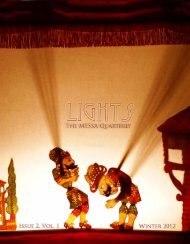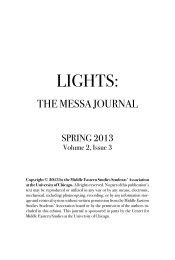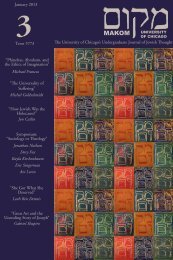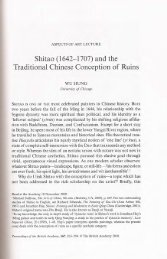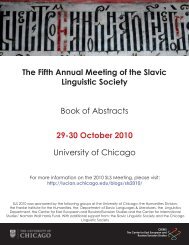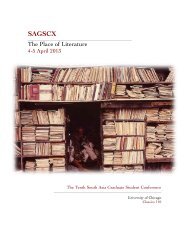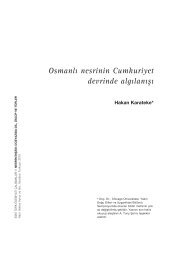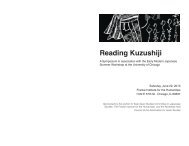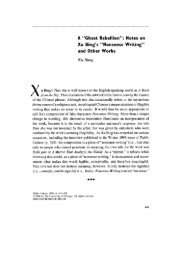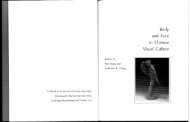Create successful ePaper yourself
Turn your PDF publications into a flip-book with our unique Google optimized e-Paper software.
<strong>THE</strong> <strong>MEDIEVAL</strong> <strong>ROUT</strong> <strong>OF</strong> <strong>THE</strong><br />
<strong>SECRET</strong> <strong>BOOK</strong><br />
MAJA JAKIMOVSKA-TOSIC,<br />
INSTITUTE <strong>OF</strong> MACEDONIAN LITERATURE<br />
sInstitute of MacMsedonian Literature
<strong>THE</strong> <strong>MEDIEVAL</strong> <strong>ROUT</strong> <strong>OF</strong> <strong>THE</strong> <strong>SECRET</strong> <strong>BOOK</strong><br />
When the review on Macedonian fiction film Cannes, Cathars and<br />
Conspiracy was published in London The Guardian on May 26, 2006,<br />
which evaluated it high above The Davinci Code, Herbert Lotman,<br />
one of the leading biographers of modern times introduced the idea<br />
of writing a novel which will give a possible reconstruction of the<br />
voyage of The Secret Book.<br />
The Novel on The Secret Book is expected to be issued in 2010,<br />
published by MONUM, Carcassone, France, by co-authors Jordan<br />
Plevnes and Maja Jakimovska-Tosic. The idea to investigate the<br />
route of The Secret Book through twelve places, from the island of<br />
Golem Grad in Prespa through South-West of Europe, to the<br />
Museum of Inquisition in Carcassone, France, has been initiated by<br />
the search for the original book and its mysterious fate, a mission<br />
which has been lasting for more than a thousand years.
<strong>THE</strong> <strong>MEDIEVAL</strong> <strong>ROUT</strong> <strong>OF</strong> <strong>THE</strong> <strong>SECRET</strong> <strong>BOOK</strong><br />
The Secret Book, a product of the medieval theosophy,<br />
known in literature as Gospel of John or False Gospel,<br />
belongs to apocryphal literature with apocalyptic and<br />
visionary orientation.<br />
The content of The Secret Book implies heretical elements,<br />
mainly typical for dualistic doctrines and especially for the<br />
doctrine of Bogomils.<br />
In its content it describes the prehistory of creation of the<br />
world, the creation itself and it also uncovers the future<br />
history of the mankind, in which, in cosmogony sense, it mixes<br />
Christian believes with non-Christian ones, based on<br />
religious-philosophical concept of moderate dualism and<br />
Gnosticism.
<strong>THE</strong> <strong>MEDIEVAL</strong> <strong>ROUT</strong> <strong>OF</strong> <strong>THE</strong> <strong>SECRET</strong> <strong>BOOK</strong><br />
This text, today, is known only through two<br />
transcripts in Latin, Parisian and Viennese versions,<br />
known by the names Carcassone and Vienna<br />
version.<br />
The translation in Latin is connected with the<br />
missionary work of bishop Nasaria in Lombardi in<br />
1170, whose goal was to spread the ideas of<br />
Bogomils among devotees of Catharism, and that<br />
was the reason why it was translated in Latin.
<strong>THE</strong> <strong>MEDIEVAL</strong> <strong>ROUT</strong> <strong>OF</strong> <strong>THE</strong> <strong>SECRET</strong> <strong>BOOK</strong>
<strong>THE</strong> <strong>MEDIEVAL</strong> <strong>ROUT</strong> <strong>OF</strong> <strong>THE</strong> <strong>SECRET</strong> <strong>BOOK</strong><br />
Our search for the presumable ubiquity of the path of<br />
The Secret Book begins in Prespa, along the transversal<br />
of its trip, which allows us to determine 12 possible<br />
toponym- markers on its movement through time and<br />
space, from Golem Grad in Macedonia to Karkason in<br />
France.<br />
Here, for the first time, we exclusively present the 12<br />
presumed places on the map of South-East Europe, Italy<br />
and South France through which The Secret Book<br />
passed.
<strong>THE</strong> <strong>MEDIEVAL</strong> <strong>ROUT</strong> <strong>OF</strong> <strong>THE</strong> <strong>SECRET</strong> <strong>BOOK</strong><br />
MACEDONIA<br />
1. PRESPA<br />
Based on certain Latin sources we could conduct presumable ubiquity<br />
of the heretic castrum in Macedonia as a possible area where The<br />
Secret Book came from. Such data are given in documented Latin<br />
sources, such as The History of Crusade to Jerusalem by Petar<br />
Tudebod, which refers to The First Crusade, whose participants<br />
travelled along the important communication route Via Ignacia,<br />
passing through south-west part of Macedonia.<br />
The author writes that in the period of 1096-1099 there was a<br />
fortified heretic settlement (castrrum haereticorum) in Pelagonia,<br />
situated by some lake (in qodam lacu). The imprecision of this datum<br />
in science allows more different opinions concerning its ubiquity. It is<br />
very possible that it is the area around the lake of Prespa.
<strong>THE</strong> <strong>MEDIEVAL</strong> <strong>ROUT</strong> <strong>OF</strong> <strong>THE</strong> <strong>SECRET</strong> <strong>BOOK</strong><br />
S. Antoljak connects the modern day village of Asamati on Prespa Lake,<br />
according to a Greek name , to the sect of Bogomils and<br />
assumes that the very place of Asamati was the above mentioned town of<br />
heretics which was situated by a lake, by some lake or near a lake. T.<br />
Tomovski, in his study Prespa in the Middle Ages points the Island as a<br />
possible location of the heretic castrum.<br />
E. Bosoki, in his book about The Secret Book gives his opinion that its voyage<br />
began exactly in 1096 when the town on Prespa island Golem Grad was<br />
burnt down.<br />
Mythical and real stories interweave here, and J. Plevnes found one of<br />
them in his researches in the library of Vatican, where he discovered a<br />
written note about a monk-Crusader, who with his tongue cut off carried the<br />
book from the island , through the Balkans, to Italy and France, a story first<br />
found somewhere near Venice and written down by the Croatian publicist<br />
Antonio Jerkov in a magazine Relacion Macedonia, published in Rome in the<br />
1960s.
<strong>THE</strong> <strong>MEDIEVAL</strong> <strong>ROUT</strong> <strong>OF</strong> <strong>THE</strong> <strong>SECRET</strong> <strong>BOOK</strong>
<strong>THE</strong> <strong>MEDIEVAL</strong> <strong>ROUT</strong> <strong>OF</strong> <strong>THE</strong> <strong>SECRET</strong> <strong>BOOK</strong><br />
2. BOGOMILA The<br />
Name of the village, on the one side, is connected, to the appellative bogomil. It is<br />
located in the area of Azot on The Babuna River (the right tributary of The Vardar),<br />
west of Veles.<br />
On the other hand, the name has been derived from the same anthroponym, the<br />
name of the founder of the doctrine, priest Bogomil; while from the semantic point<br />
of view it has the meaning-the village which belongs to Bogomil.<br />
According to the existing original material, which mainly comes from Sermon<br />
Against New Heresy by Presbyter Kosma, it is pointed out that the activity of priest<br />
Bogomil happened in the time of Bulgarian Czar Petar (in the period between 927<br />
and 969).<br />
According to one tradition, priest Bogomil’s place of birth was the village of<br />
Bogomila, and his grave and a small paraclis were in its vicinity, near the so called<br />
church-yard, which served as a house of prayers of Bogomils. It is believed that<br />
during persecutions, priest Bogomil’s tomb was used as a shelter and a house of<br />
prayers for followers, the right place for The Secret Book.
<strong>THE</strong> <strong>MEDIEVAL</strong> <strong>ROUT</strong> <strong>OF</strong> <strong>THE</strong> <strong>SECRET</strong> <strong>BOOK</strong><br />
3. BABUNA<br />
The meaning of the term babun basically is-a man with a wrinkled face,<br />
Bogomil, a member of a heretic sect. It is basically acceptable to assume<br />
that the term babun was used for old, spiritual fathers, probably the ones<br />
of perfect Bogomils.<br />
This appellative is evident in many toponym-markers in Macedonia: the<br />
mountain of Babuna (between Prilep and Veles), The Babuna River, the<br />
area called Babuna in the western part of Klepa mountain, which is<br />
situated along the basin of The Babuna River, the village of Babuna, at the<br />
mouth of The Babuna in The Vardar River.<br />
D. Dragojlovic explains the heretic appellative babun (from babini, as a<br />
synonym for Middle East Bogomils), which was brought by Syrian heretics,<br />
who were sent by Czar John Tsimiski to colonize Tracia and Macedonia. He<br />
identifies the adaptation of babini into babuna in Macedonia, in the area<br />
of the mountain with the same name, as a centre of Bogomil herecy.
<strong>THE</strong> <strong>MEDIEVAL</strong> <strong>ROUT</strong> <strong>OF</strong> <strong>THE</strong> <strong>SECRET</strong> <strong>BOOK</strong><br />
BOSNIA ( HERCEGOVINA)<br />
4. TREBINJE<br />
By the end of the 12 th century and the beginning of the 13 th<br />
century, Bogomil movement entered Bosnia, and its followers,<br />
there known as Patarens and Kutugers appeared during the<br />
reign of Banh Kulin (1180-1204).<br />
There are controversial opinions concerning the identification<br />
of Bosnian Church, but in the official science the opinion<br />
which prevails is that it was a dualistic institution, which had<br />
similar tendencies to Bogomil movement in questions of<br />
theology and dogmatism.
<strong>THE</strong> <strong>MEDIEVAL</strong> <strong>ROUT</strong> <strong>OF</strong> <strong>THE</strong> <strong>SECRET</strong> <strong>BOOK</strong><br />
In Bosnia we also find culture phenomenon within the domain of material<br />
culture, known as specific type of grave stones, so called stecci, through<br />
which the connection with esoteric doctrine of Bogomil and Cathar<br />
movement is realized and apparent.<br />
There were two stone-carving art schools on the territory of Bosnia: East-<br />
Hercegovina and East-Bosnia (sarcophagus, floral motives and similar).<br />
Central and South-West Bosnia with their specific features represent<br />
transitive territory.<br />
According the statistics in the territories of Nevesinje, Konjic, Rogatica,<br />
Trebinje, Stolac, Ludmer, Livno, the necropolis with stecci are the most<br />
numerous (2000-3000 pieces), and almost half of the inscriptions comes<br />
from those areas.<br />
The vicinity of Dubrovnik to Trebinje might have dictated the development<br />
of the region, the character of population and its culture and religious role,<br />
in accordance with the social and political situation. In our opinion those<br />
circumstances directed the line of movement of The Secret Book, as an area<br />
which offered favourable conditions for its dispersion and transition.
<strong>THE</strong> <strong>MEDIEVAL</strong> <strong>ROUT</strong> <strong>OF</strong> <strong>THE</strong> <strong>SECRET</strong> <strong>BOOK</strong>
<strong>THE</strong> <strong>MEDIEVAL</strong> <strong>ROUT</strong> <strong>OF</strong> <strong>THE</strong> <strong>SECRET</strong> <strong>BOOK</strong><br />
5. MOSTAR<br />
The region of Listica in the very viciniry of Mostar, is the area with the<br />
densest concentration of stecci. In this direction is the rout which could have<br />
been formed among Trebinje, Bileca, Stolac, Mostar, Imotski and Split, as a<br />
possible transversal on which The Secret Book moved along.<br />
The area of Listica, when the number and the location of necropolis is<br />
considered, was densely populated, before and especially in the 14 th and<br />
the 15 th century, although Mokro and Ledinac were the central (ruling)<br />
places in the region.<br />
It is believed that the whole region was populated with different<br />
fraternities, and there were one or more necropolis on each territory of the<br />
fraternities.<br />
Several specially carved stecci stand out at these necropolis, which were<br />
probably carved for the leaders of those fraternities. At some of the<br />
necropoles the finer hierarchy is even evident, with images of chiefs, khmets,<br />
and ordinary people.
<strong>THE</strong> <strong>MEDIEVAL</strong> <strong>ROUT</strong> <strong>OF</strong> <strong>THE</strong> <strong>SECRET</strong> <strong>BOOK</strong>
<strong>THE</strong> <strong>MEDIEVAL</strong> <strong>ROUT</strong> <strong>OF</strong> <strong>THE</strong> <strong>SECRET</strong> <strong>BOOK</strong><br />
CROATIA-DALMATIA<br />
6. IMOTSKI<br />
Acts of Cathar Assembly, held in 1167 in San Felix de Carmen, near<br />
Toulous, France, represent an important historic source when the question of<br />
existence of heretic church organizations is considered.<br />
Pope Nikita of Constantinople, who belonged to heretic church of<br />
Dragovitia, known for its strict dualistic orientation, chaired the Assembly.<br />
There he speaks of existence of churches of Romania, Drogometia,<br />
Melingia, Bulgaria and of Dalmatia, and points out that they are<br />
separated and fortified and that they live in peace.<br />
It is probable that The Secret Book from Macedonia and Bosnia arrived in<br />
Croatia, and then was transferred to Lombardi, a strong center of Cathars.<br />
The very region of Imotska kraina, the area between The Cetina and The<br />
Neretva River, kept its strategic and trading importance throughout the<br />
Middle Ages as an important communication rout in Dalmatia hinterland.
<strong>THE</strong> <strong>MEDIEVAL</strong> <strong>ROUT</strong> <strong>OF</strong> <strong>THE</strong> <strong>SECRET</strong> <strong>BOOK</strong><br />
Such a position of Imotski can be followed through<br />
recorded necropoles, which represent a type of marker<br />
of demographic-economic and religious situation of the<br />
region itself.<br />
Through the transitional area of Makarska cost<br />
(Makarsko primorje), Kasteli and Trogir hinterland<br />
(Trogirska zagora), where, almost exclusively, steccislabs<br />
with a sword and a shield, a cross and solar-lunar<br />
symbols are found, these signs of iconography enter<br />
towns in Dalmatia (Omis, Split, Trogir).<br />
The Secret Book followed this communication connection<br />
as a line which includes in itself much deeper symbolism.
<strong>THE</strong> <strong>MEDIEVAL</strong> <strong>ROUT</strong> <strong>OF</strong> <strong>THE</strong> <strong>SECRET</strong> <strong>BOOK</strong><br />
7. SPLIT<br />
The foundation of Dalmatian heretic church could have been realized in two<br />
different ways: one of them, because of the vicinity of extremely strong<br />
Bosnian Bogomil center, and the other through strong trading connections<br />
between Constantinople and Dalmatia, where Split and Trogir are centers,<br />
and where the route of movement of Cathars and dualists can be followed<br />
in the period of the year1250.<br />
Although the influence of the Split archbishopric, which gained its primacy<br />
during the time of Tomislav (the beginning of 10 th century) on basis of<br />
historic right, is also very strong, it narrows its jurisdiction during the 11 th<br />
and 12 th century, when the influence of Hungarian church rises, as well as of<br />
Zagreb, Zadar and Dubrovnik archbishopric. Nevertheless, Split as an<br />
important political, trading, diplomatic and communicational centre of<br />
medieval period fulfilled the role of a bridge for goods and religious<br />
movements from East to West. Through Split, as through an important<br />
communication crossroad of the Middle Age, the message of The Secret<br />
Book was probably transferred to the western world.
<strong>THE</strong> <strong>MEDIEVAL</strong> <strong>ROUT</strong> <strong>OF</strong> <strong>THE</strong> <strong>SECRET</strong> <strong>BOOK</strong>
<strong>THE</strong> <strong>MEDIEVAL</strong> <strong>ROUT</strong> <strong>OF</strong> <strong>THE</strong> <strong>SECRET</strong> <strong>BOOK</strong><br />
8. KRK<br />
Before the translation in Latin appeared, the original<br />
linguistic and language features of The Secret Book,<br />
and its original glagolic alphabet, found a fertile soil<br />
on the island of Krk, where the centuries long tradition<br />
of glagolic alphabet is evident.<br />
Banh Zvonimir ensured stable position and reign in<br />
towns in Dalmatia in the second half of the 11 th century<br />
(he was pronounced King in 1075 in the basilica of St<br />
Peter in Solin). He strengthens the Benedictine monastic<br />
order in the monasteries in Dalmatia.
<strong>THE</strong> <strong>MEDIEVAL</strong> <strong>ROUT</strong> <strong>OF</strong> <strong>THE</strong> <strong>SECRET</strong> <strong>BOOK</strong><br />
The well known incrription on the Basca slab (Bascanska ploca-around<br />
AD1100), from the island of Krk, proves it; written in 13 lines in<br />
Glagolic alphabet. The inscription writes that two Benediction monks<br />
founded the monastery on the island of Krk, and whose ktitor was<br />
King Zvonimir.<br />
In the period when the slab was carved and inscribed King Zvonimir<br />
was already assassinated, foreseeing hard, tragic times for his<br />
subjects and countrymen and a long period of political (and<br />
religious) turmoil. Indeed, after his death a long period of turmoil<br />
and chaos set in, in Croatia, which does not exclude religious turmoil<br />
as well.<br />
The Secret Book with its dualistic orientation followed the line of<br />
events at the times, while its content made allusions to apocalyptic<br />
predictions of its contemporaries. Its transfer from the island of Krk<br />
towards West had already been prepared.
<strong>THE</strong> <strong>MEDIEVAL</strong> <strong>ROUT</strong> <strong>OF</strong> <strong>THE</strong> <strong>SECRET</strong> <strong>BOOK</strong>
<strong>THE</strong> <strong>MEDIEVAL</strong> <strong>ROUT</strong> <strong>OF</strong> <strong>THE</strong> <strong>SECRET</strong> <strong>BOOK</strong><br />
ITALY<br />
9. LOMBARDI<br />
The appearance of its translation in Latin is connected with the<br />
missionary activities of bishop Nasari in Lombardi, which had a goal<br />
of spreading the ideas of Bogomols among the Cathar devotees.<br />
Bacause Nasari in 1170 already presented a part of its content to<br />
the audience, it is believed that it had been translated around the<br />
mid 12 th century. In the second half of the 13 th century we find an<br />
allusion on The Secret Book made by Reiner Saconi, who, in 1230,<br />
when writing-about Cathars and the poors of Lion-points out that he<br />
learnt that illusion from the elder son of Bulgarian church-Nasari,<br />
about 60 years earlier.
<strong>THE</strong> <strong>MEDIEVAL</strong> <strong>ROUT</strong> <strong>OF</strong> <strong>THE</strong> <strong>SECRET</strong> <strong>BOOK</strong><br />
10. CONCOREZZO<br />
In the connection with point of Concorezzo as a possible place of<br />
transfer of The Secret Book, we would like to mention the comment of<br />
the Italian theologian and inquisitor Anselmo of Alexandria in his<br />
Treatise on Heretics, written from 1260 to 1270, who at the end of<br />
Carcasson transcript underlines: “This is a secret of the heretics of<br />
Concorezzo, full of illusions, brought from Bulgaria by their bishop<br />
Nasari”.<br />
Recently Borst found out that in the radically dualistic Octicania by<br />
the end of the 13 th century, the doctrines of ancient-bogomil<br />
moderate dualism often appeared and that Italian Cathar envoys<br />
often visited their mother bishoprics on the Balkans, which also<br />
proves their intensive relations in the later periods. This on the other<br />
hand supports the relevance of the idea of continuous transfer of<br />
ideas in the medieval period.
<strong>THE</strong> <strong>MEDIEVAL</strong> <strong>ROUT</strong> <strong>OF</strong> <strong>THE</strong> <strong>SECRET</strong> <strong>BOOK</strong><br />
FRANCE<br />
11. CARCASSON<br />
The irrefutable evidence that The Secret Book passed through Carcasson is<br />
the Carcasson transcription in Latin itself. Admitting that Cathar in Albia was<br />
a very strong movement between 1185 and 1227, Ellie Grif says that it is<br />
still not possible to conclude that in those places Cathars were numerous or<br />
a majority because there are no evidence of that. For the time being it can<br />
only be given a relative picture of the number of Cathar strength.<br />
This point of view can be broaden by a dynamic examination of Cathar<br />
movements in Okcitania in northern Italy, especially in Lombardi, which<br />
became a promised land to heretics after the surrender of Monsegur in<br />
1244. In the second book of Inquisition Gerard mentions ductores<br />
hereticorum, as well as names of people whom those leaders transferred<br />
from Okcitania through the Mediterranean Alps, Nice and Col de Tend to<br />
Rokavionea and from there to the valley of Kunea, known as introitis<br />
Lombardiae. This is the evidence of living and dynamic connections of<br />
Cathars in the region of Okcitania and Lombardi.
<strong>THE</strong> <strong>MEDIEVAL</strong> <strong>ROUT</strong> <strong>OF</strong> <strong>THE</strong> <strong>SECRET</strong> <strong>BOOK</strong><br />
12. MONSEGIR<br />
In the town of Monsegur in 1196, a hundred years after<br />
the presumed writing of The Secret Book, the biggest<br />
execution of Cathars was committed.<br />
Upon the order of Simon de Monfor 3260 Cathars<br />
were burnt alive. When Monfor was asked if all should<br />
be burnt as there were righteous ones from whole<br />
Europe who believed the true God, Monfor stated the<br />
known statement:<br />
“Burn them all, and in Heaven God will<br />
recognize the righteous ones”.
<strong>THE</strong> <strong>MEDIEVAL</strong> <strong>ROUT</strong> <strong>OF</strong> <strong>THE</strong> <strong>SECRET</strong> <strong>BOOK</strong><br />
The process of dispersion of The Secret book still<br />
represents a not-completely solved puzzle, as the<br />
sources are not entirely precise, and a great many of<br />
them are destroyed because of their heretic character.<br />
It is necessary to determine more concrete ubiquity of<br />
presumptuous movement of the book, through relevant<br />
supportive evidence, from Bosnia and Dalmatia to Italy<br />
and France, in fact-the route of the active transfersal<br />
which is one of the biggest mysteries in modern Europe,<br />
and which was, on its spiritual level, initiated by the fate<br />
of one book.
Д. Ангелпв, Бпгпмилствптп в България, Спфия 1961.<br />
Маја Ангелпвска-Панпва, Бпгпмилствптп вп духпвната култура на Mакедпнија, „Аз –Буки - Скппје, Институт за<br />
старпслпвенска култура“ – Прилеп 2004<br />
С. Антплјак, Асамати (Една тпппнимска загатка). Истприја, IV/2, Скппје 1968, стр. 100-101.<br />
Бпгпмилствптп на Балканпт вп светлината на најнпвите истражуваоа, Збпрник пд симппзиумпт пдржан вп<br />
Скппје на 30, 31 мај и 1 јуни 1978 гпдина, Скппје 1982.<br />
M. Barber, The Cathars. Dualistic Heretics in Languedoc in the High Middle Ages. Harlow 2000, 83.<br />
Драгпљуб Драгплпвиќ, Вера Антиќ, Бпгпмилствптп вп среднпвекпвната извпрна града, Скппје 1978<br />
D. Dragojlović, Bogomil political roll among the Balcan nations, Balcanica, 1. Belgrade 1979.<br />
Д. Драгпјлпвић, Манихејска Тајна коига у јужнпслпвенскпј коижевнпсти, Коижевна истприја VI, 23, 1974, 514.<br />
Драгпљуб Драгпјлпвић, Истприја филпзпфске мисли у Срба еппхе феудализма, Нпви Сад 1998.<br />
Й. Иванпв, Бпгпмилски книги и легенди, Спфия 1970<br />
Т. Тпмпвски, Преспа вп среднипт век, Истприја XV/2, Скппје 1979.<br />
Edina Bozoky, Le livre secret des cathares. Interrogatio Iohannis, Apocryphe d'origine bogomile, edition critique, traduction,<br />
commentaire, Paris, Beauchense, 1980.<br />
Jordan Plevnes, 100 minutes pour 1000 ans, Ou voyage entre la copie et l'original. À propous du scénario du film Le livre<br />
secret, Slavia occitania, Bogomiles, Patarins et Cathares, Numéro 16, Toulouse 2003, 393-398.<br />
B. Hamilton, Wisdom from the East. Heresy and Literacy 1000 – 1530. Cambridge 1994, 53-56.



